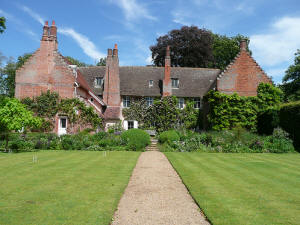|
Blo' Norton is a small village on the Norfolk-Suffolk
border. It lies on the River Little Ouse just above Blo' Norton Fen.
The name probably derives from a 'bleak or cold north
enclosure' (blaw + north + tun).
In the summer of 1906 Virginia Woolf (1882-1941) came
to stay at Blo' Norton Hall. The hall, a moated
Elizabethan manor, lies at the end of a long avenue of
lime trees immediately before Blo' Norton Church.

Blo' Norton Hall
(Photograph by Dale Reynolds)
The hall provided the setting for her short story
The Journal of Miss Joan Martyn. In the story the
main character, Rosamund Merridew, is a historian
researching England's land-tenure system.
This part of Norfolk is particularly isolated and
Woolf records in her diary the journey from Diss
railway station:
|

